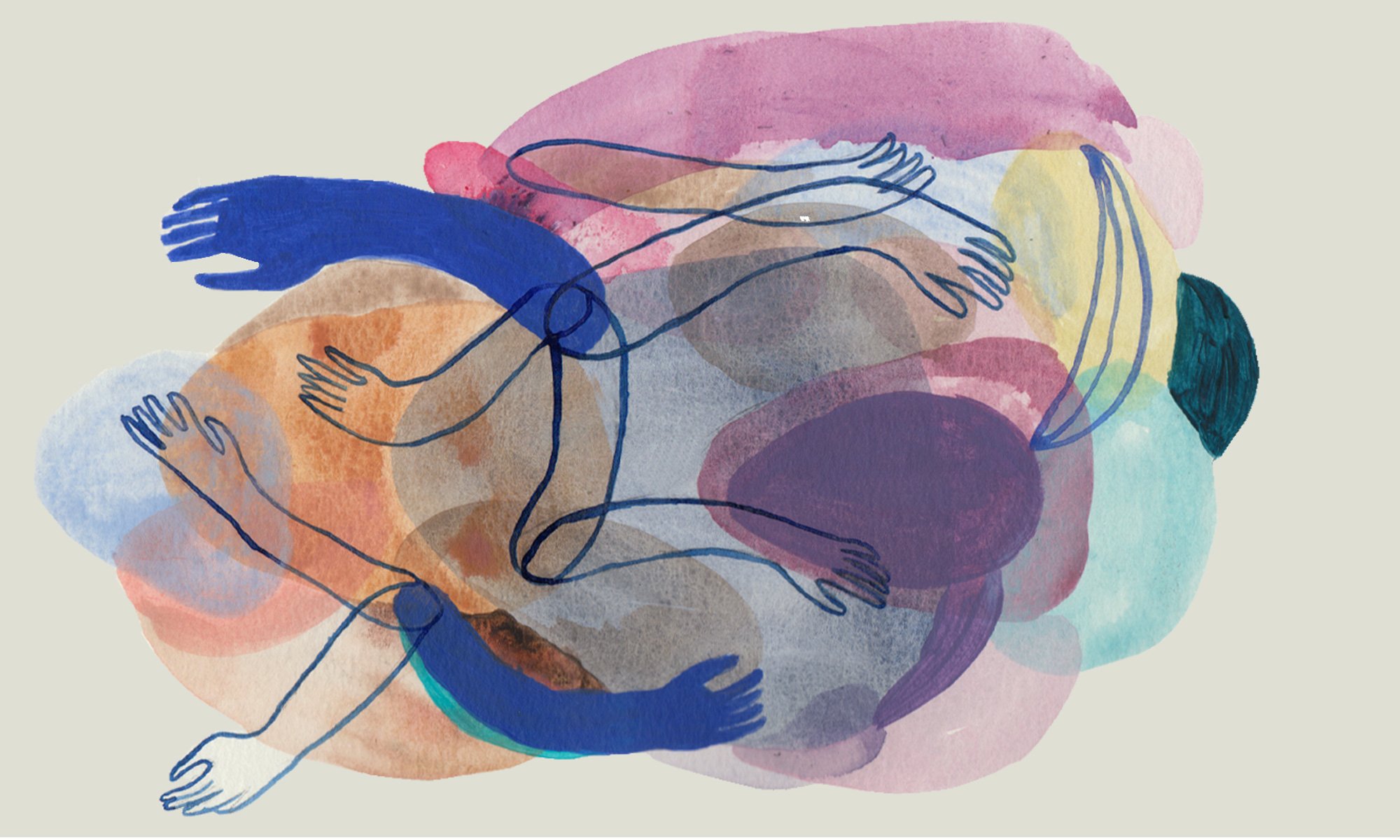Power and domestic work in Bolivia’s lowlands
An original watercolor on the theme of collective work and diversity by Bolivian artist María José Vera.
Interview • Claudia Cuellar • August 25, 2023 • Leer en castellano
Beni is a territory traversed by rivers and dotted by lakes, where Andean streams flow into the tributaries of the Amazon. It's the name of a department in northern Bolivia—the second largest in the country—where the Amazonian region meets subtropical rainforest savannah.
Cattle ranching is the most important economic activity in Beni, and the department's "productive" economy is organized around it. This territory is home to most of Bolivia’s cattle. According to data from the 2012 census, and projections to the year 2021, Beni has a population of just over half a million inhabitants. For every inhabitant, there are approximately six head of cattle.
In addition to being a hub for cattle ranching, Beni is an Indigenous territory inhabited by more than 18 Indigenous nations, whose social and economic transformations are also shaped by various extractivist activities.
Although Bolivia is largely made up of lowlands, the most common understandings of its society have focused on the history of the mountainous Andean region and its diverse forms of social organization. The realities and histories of departments such as Beni are opaque and usually only studied when something of note takes place there.
This interview is a conversation with Ilze Monasterio Zabala and Zoren Álvarez Salazar, two young researchers from Beni who, in their own work, trace the interplay between violence against women, precariousness, and the power of cattle ranchers.
Monasterio Zabala and Álvarez Salazar work to raise visibility of an issue that is little talked and written about: domestic work and the reproduction of life in on haciendas, or colonial style cattle ranches and plantations. In this conversation, we approach the territory through the eyes of two young feminist researchers who are thinking critically about how Beni has traditionally been studied.
Monasterio Zabala is a feminist and sociologist from Beni who researches gender violence and the situation of women in the Bolivian lowlands. Álvarez Salazar is a Benian sociologist and works with women from marginalized communities. Both live in Trinidad, the capital of Beni, and intermittently in other Bolivian cities for reasons related to their work.
The land issue in Beni has been transformed and complicated by the arrival of new actors, but it is still necessary to scrutinize the power of plantation owners vis a vis experiences of domestic labor.
This approach shows us how violence is required for the control of feminized bodies, and illuminates the possibility of encouraging more complete perspectives on social conflicts in relation to the possession and distribution of land in Bolivia.
This interview is the product of two conversations with Monasterio Zabala and Álvarez Salazar, one held in person and another online in June of this year. Together, we edited our interview during the month of July, and it was translated by Ojalá in August.
Claudia Cuellar: Why did you decide to research within the territory where you were born and live? Why research domestic work on cattle ranches?
Ilze Monasterio Zabala and Zoren Alvárez Salazar: Zoren and I are sociologists who are from el Beni, we were raised here, our history is entirely linked to the history of this territory.
The history of the Beni has always been based on livestock. Cattle ranching is the main livelihood of this territory and a central axis of its social hierarchy. Cattle ranching is also a system of customs and beliefs that isn't well understood, nor has it been studied in depth.
We sensed this gap in knowledge and information since we were students, and later in our university studies. We never had a clear idea of what cattle ranching was like, much less for women, so we wanted—and want—to know: What has been the impact of cattle ranching on women's lives?
We know that in Beni, cattle ranching has relied heavily on the systematic exploitation of women's labor and the violation of their rights.
The ranching system, which is a remnant of a feudal system, is founded on the exploitation of women's labor from childhood and adolescence through to adulthood.
CC: As you've told us, you start with a concern, namely the set of exploitations against women, could you name some of them?
IMZ: For starters, there is deep racial exploitation. Indigenous people have been and continue to provide cheap labor for the cattle system to keep functioning, and this is compounded by class oppression in the territory. Within these fiefdoms [the haciendas], castes are created. The owners take advantage of the work of overseers and laborers alike. They constantly profit from cheap, underpaid and sometimes unpaid labor.
But this exploitation targets women in particular, because for the most part, women who work on the haciendas carry out domestic work and don't receive any kind of salary, let alone social security.
IMZ and ZAS: The violence [women on haciendas] endure is very intense. It's a devastating situation, because in addition to all the labor exploitation, the patriarchal culture at home is unrelenting. They are abused within the labor system and inside their homes. They face economic violence and even extreme physical violence such as femicides. This type of violence is often covered up by the hacienda system.
In order to build a larger pool of laborers, the aim of the system is for women to bear large amounts of children starting at an average of 14 years of age.
ZAS: In terms of labor exploitation—if they are paid at all—wages are approximately 600 bolivianos (US$90) per month in the best of cases. Such a wage would be paid for cooking for 12 men on the estate, washing clothes, and sometimes even washing the administrator's clothes.
In some cases the women are only paid for the food they prepare, for the rations they cook. That’s why job ads always say "looking for a live-in worker with a wife."
That’s also why when a woman goes alone to work in an estate, they try to force her to marry another man who works there, the preference is for them to have children because they also become workers. While in some cases there are schools, education is dismal because there are no teachers.
Obviously, the owner of the hacienda is rich, an upper class member of the Beni elite. If you wanted to file a complaint about violence or labor abuses, it would cost you at least 110 bolivianos. Because the offices are in Trinidad, unfortunately it becomes risky and costly to do so.
CC: How do you view the figure of the employer in el Beni? What does the employment relationship mean to you?
IMZ: From my perspective, the employer is the boss and at the same time plays the role of the father by making the others dependent on him.
For example, everyone in Trinidad wants their own motorcycle, even though people spend most of their time in the cattle ranches, they still want a motorcycle. What do they do? They go and ask the boss, the owner or, in a way, the father; and since he has the money, he lends it to them and thus generates relationships of dependency and a debt that goes beyond cattle ranching business.
We see the figure of the boss as that of a capitalist who gradually alienates his workers, including the overseer, the women, and the children, generating relations of constant alienation. The boss expropriates the surplus value of labor, from the administrator all the way down to the last link, the daughters of the women in the haciendas.
This structure has an effect on the city of Trinidad and others because castes are created within the social hierarchy. They have taken root from generation to generation through a profound historical process that is very difficult to alter.
Bosses reproduce their social capital in politics, in social life, in the whole ordering of Trinidad. For example, those who hold economic power, those who hold the power of private property, are the same who hold the power of livestock production. They also wield political power in this territory, and that cuts across political parties. The owners of large haciendas have also become important politicians in el Beni.
Politicians respond to the economic power of these elites. That’s how things work in this territory, and these are issues that are hardly understood or discussed.
CC: How do you identify the different aspects of the hierarchy of work on the haciendas?
ZAS: You have the owner of the ranch, who has an administrator who is a professional either a veterinarian or a zootechnician. Then there are the workers, the ranch hands, as they’re called. On some estates, or the ones I know of that pay women, their wages don't even reach the national minimum wage.
The women's work is the work of cooking and feeding the workers. Just like the ranch hands, laborers and managers, women get up at 5:00 a.m. to make breakfast, sweep, clean and do all the domestic work, in addition to the work in their own homes.
The boss—and the entire the Benian elite—benefits from the servitude of women. At the top is the boss of the cattle ranching elite and at the bottom are the workers they need most to reproduce their workforce: women who (mostly) work for free, and of course in their own homes outside the hacienda.
This can only be upheld through violence and control of women's bodies, since in these places information or access to contraceptive methods is not allowed or provided, and severe punishments are administered when the subject is even brought up.
In this context, women engage in everyday rebellions such removing children from the haciendas, engaging in collective conversations and collective care against violence, and through midwifery. These dynamics encourage us to think about power and struggle in these territories.
CC: Problematizing the system of labor from the perspective of domestic work allows us to see how work and the energy is subordinated by power in much of Beni. Of course this is not homogeneous to all haciendas, or in the entire territory.
•••
Monasterio Zabala and Álvarez Salazar invite us to think about power and territory from perspectives that are constantly made invisible. Their outlook connects with daily struggles for the reproduction of life that are constantly taking place in Beni, and which have been overshadowed by narratives in which the hacienda structure encompasses all and depict the region a "conquered territory.”


